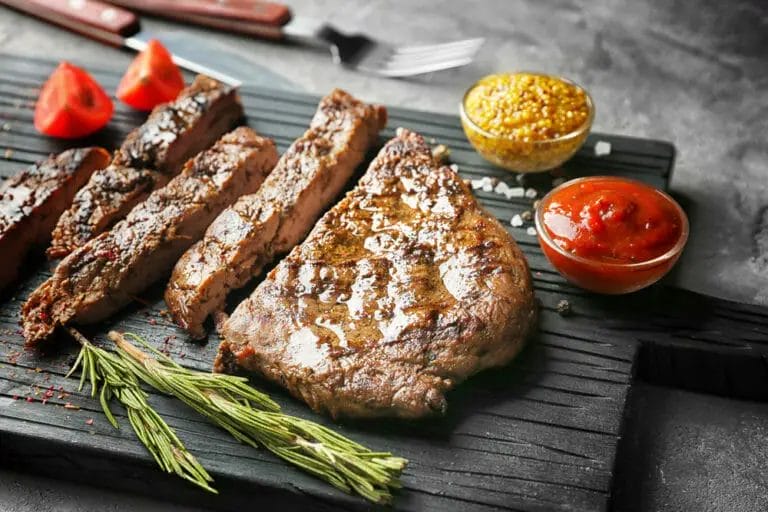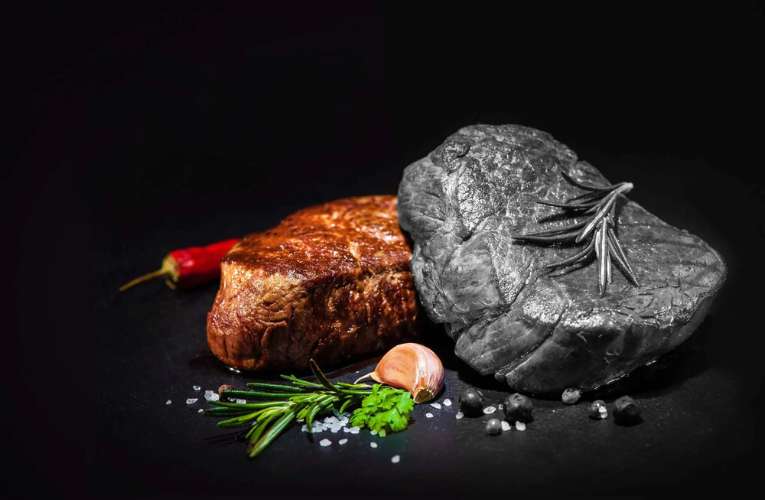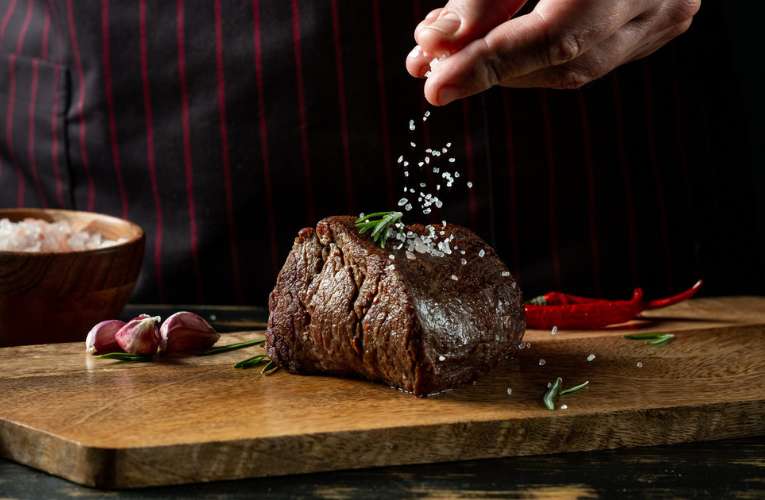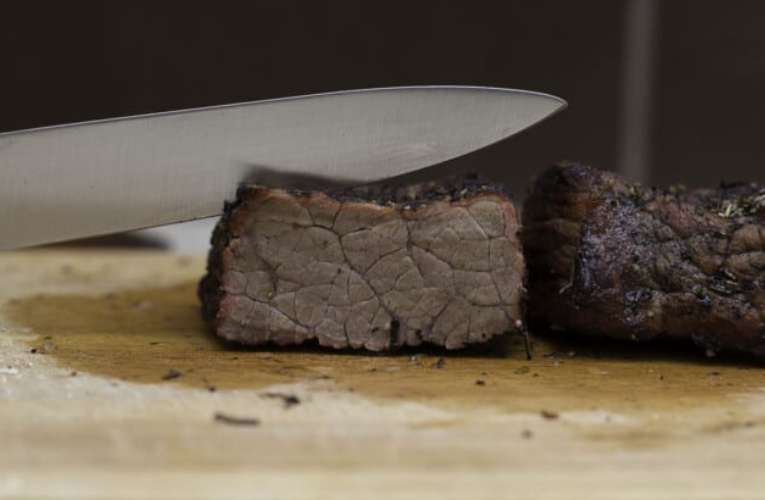If you’ve ever wondered why your steak turns out grey instead of that desired juicy and brown color, there are a few reasons that might be causing this lack of appetizing appearance.
One possible reason is overcooking, as the heat can cause the proteins in the meat to denature and turn it grey. Another factor could be insufficient browning during the cooking process, resulting in a less appealing color.
Additionally, using low-quality meat or improper storage methods can also contribute to a greyish hue. Read on to discover how to achieve that perfect, appetizing steak color.

How to Properly Cook a Steak to Avoid Grey Coloring
When it comes to cooking a steak, achieving the perfect sear and juiciness is of utmost importance. However, sometimes you may encounter the undesirable grey coloring on the surface of the meat.
This can be disappointing, as it affects both the appearance and taste of the steak. In this section, we will discuss the reasons behind the grey coloring and share some tips on how to properly cook a steak to avoid this issue.
1. Understanding the Maillard Reaction
The Maillard reaction is a chemical reaction that occurs when proteins and sugars are heated together. It is responsible for the browning and flavor development in various types of cooked food, including steaks.
However, if the steak is not cooked properly, the Maillard reaction may not occur fully, resulting in a grey color.
2. Start with High Heat
One of the key factors in achieving a good sear and avoiding grey coloring is starting with high heat. Preheat your cooking surface, whether it’s a grill or skillet, to a high temperature.
This initial blast of heat will help caramelize the proteins on the surface of the steak, creating a flavorful crust and preventing the development of a grey color.
3. Pat Dry and Season the Steak
Prior to cooking, make sure to pat dry the steak with a paper towel. Excess moisture on the surface of the meat can interfere with the Maillard reaction and contribute to a grey color. Additionally, season the steak generously with salt and pepper or your preferred seasoning blend to enhance the flavor.
4. Avoid Overcooking
Overcooking a steak can lead to a dry and grey interior. To avoid this, it’s essential to cook the steak to the desired level of doneness without surpassing it.
Use a meat thermometer to monitor the internal temperature and remove the steak from the heat source a few degrees below your target temperature. The residual heat will continue to cook the steak as it rests.
5. Rest the Steak
Resting the steak after cooking is a crucial step that allows the juices to redistribute within the meat. Tent the steak loosely with aluminum foil and let it rest for about 5-10 minutes before slicing into it. This resting period will help retain the juiciness and result in a more appealing color.
6. Sear After Sous Vide
If you prefer using the sous vide method for cooking steaks, you may encounter the issue of grey coloring. To counter this, sear the steak in a hot skillet or grill for a short period after it has been cooked sous vide.
This final sear will provide the desired browning and enhance the overall appearance of the steak.
7. Quality of the Meat
Last but not least, the quality of the meat plays a significant role in the color and taste of the cooked steak. Choose a high-quality cut of meat from a reputable source. Prime cuts, such as ribeye or filet mignon, tend to have a better marbling and flavor profile, resulting in a more desirable color.

Understanding the Role of Meat Aging and its Impact on Steak Color
Meat aging is a crucial process in the preparation of steaks that directly influences the final color and quality of the meat. In this section, we will delve into the significance of meat aging and how it affects the color of steaks.
1. What is meat aging?
Meat aging refers to the controlled decomposition of meat under specific conditions, allowing enzymes and natural processes to break down proteins and enhance flavor and tenderness. This process can be achieved through two methods: dry aging and wet aging.
2. Dry aging and its impact on steak color:
Dry aging involves hanging meat in a temperature and humidity-controlled environment for a certain period, typically around 21 to 35 days.
During this process, the meat undergoes a natural enzymatic breakdown, leading to the evaporation of moisture. The reduction in moisture concentration results in a more concentrated flavor and tender texture.
When it comes to steak color, dry aging has a notable impact. The exposure to air and the controlled drying process in dry aging leads to the formation of a thin layer of mold on the surface of the meat.
This mold creates a natural barrier that helps prevent the growth of harmful bacteria and enhances the meat’s flavor. The development of mold may also contribute to a darkening of the outer layer of the steak, resulting in a rich, deep brown color.
3. Wet aging and its impact on steak color:
Wet aging, on the other hand, involves vacuum-sealing meat in plastic bags immediately after slaughtering and storing it in a refrigerated environment for a specific time, usually around 7 to 14 days. This method allows the meat to age while retaining its moisture content.
In terms of steak color, wet aging generally does not have a significant impact on the outer appearance of the meat. The color of wet-aged steaks typically remains relatively unchanged, with a bright red hue.
However, it is important to note that wet aging can still improve the tenderness and flavor of the meat through the natural enzymatic breakdown that occurs during the aging process.
4. Factors affecting steak color:
While meat aging plays a key role in steak color, other factors can also influence the final appearance:
- Meat freshness: Freshly slaughtered meat tends to have a vibrant red color.
- Oxygen exposure: Exposure to oxygen can cause meat to undergo a natural color change, from bright red to a darker shade.
- Meat quality: The quality of the meat itself, including factors like breed, diet, and processing, can impact the color and overall appearance of the steak.

The Science Behind the Grey Color in Cooked Steaks
Have you ever wondered why a perfectly cooked steak can sometimes appear grey instead of the desired pink or red color? The answer lies in the science behind the cooking process and how it affects the proteins in the meat.
When a steak is cooked, it undergoes a series of chemical reactions that result in changes to its color and texture. One of the key factors that contribute to the grey color of cooked steaks is the denaturation of proteins.
Proteins are made up of long chains of amino acids that are folded into specific shapes. When heat is applied to the meat, these proteins begin to unfold and denature. This denaturation causes the proteins to lose their original structure, resulting in a change in color.
The grey color in cooked steaks is primarily due to the formation of a compound called metmyoglobin. Metmyoglobin is formed when the iron in the protein, myoglobin, reacts with oxygen. This reaction occurs more rapidly in the presence of heat, causing the meat to turn grey.
Another factor that can contribute to the grey color of cooked steaks is the Maillard reaction. The Maillard reaction is a chemical reaction that occurs between amino acids and reducing sugars when exposed to high temperatures. This reaction results in the browning of the meat and can contribute to the overall grey color.
It is important to note that the grey color in cooked steaks does not indicate that the meat is undercooked or unsafe to eat. While some people may prefer their steaks to be cooked to a specific level of doneness, the grey color is simply a result of the chemical reactions that occur during the cooking process.
To achieve the desired pink or red color in cooked steaks, it is recommended to use cooking methods that minimize the amount of denaturation and metmyoglobin formation. For example, cooking steaks at lower temperatures or using sous vide techniques can help retain the natural color of the meat.

Tips and Tricks to Enhance the Appearance of Steaks for a Perfectly Browned Result
When it comes to cooking steaks, achieving that perfectly browned appearance can make all the difference in the overall presentation and taste. A beautifully seared steak not only looks appetizing but also adds a depth of flavor that enhances the overall dining experience.
In this section, we will explore some expert tips and tricks to help you elevate the appearance of your steaks and achieve that coveted golden brown crust.
1. Start with Quality Steaks
The first and most important step towards achieving a perfectly browned steak is to start with high-quality cuts of meat. Look for well-marbled steaks with a good amount of fat running through the meat. This intramuscular fat not only adds flavor but also helps to ensure a juicy and tender steak.
2. Pat Dry the Steaks
Before you start cooking, make sure to pat dry the steaks using a paper towel. Moisture on the surface of the steaks can interfere with the browning process, resulting in a less desirable appearance. Removing excess moisture will allow the steaks to develop a beautiful crust.
3. Preheat the Cooking Surface
One key tip for achieving a perfectly browned steak is to preheat the cooking surface. Whether you are using a grill, stovetop, or oven, it is important to ensure that the cooking surface is hot before placing the steaks on it.
This initial burst of heat helps to sear the surface of the meat, creating that delicious brown crust.
4. Use a Hot Cooking Fat
When searing steaks, it is essential to use a cooking fat with a high smoke point, such as vegetable oil or clarified butter. Heating the fat until it is hot but not smoking will help to prevent sticking and promote even browning.
Make sure to coat the steaks with the fat before placing them on the hot cooking surface.
5. Avoid Overcrowding the Pan
For a perfectly browned result, avoid overcrowding the pan or grill. Cooking too many steaks at once can lower the temperature of the cooking surface, preventing proper browning. Give each steak enough space to allow the heat to circulate evenly, ensuring that each piece achieves a desirable crust.
6. Resist the Urge to Flip Too Soon
While cooking steaks, it can be tempting to constantly flip them. However, this can inhibit the browning process.
To achieve a deep caramelized crust, resist the urge to flip the steaks too soon. Allow them to cook undisturbed for a few minutes on each side before flipping, ensuring a beautiful brown color.
7. Utilize the Maillard Reaction
The Maillard reaction is a chemical reaction that occurs between amino acids and reducing sugars, resulting in the browned appearance and rich flavors.
To enhance the Maillard reaction, consider adding a sprinkle of sugar or a dash of Worcestershire sauce to the steaks before cooking. This will help to promote browning and intensify the flavors.
8. Rest the Steaks
After cooking, it is crucial to allow the steaks to rest before slicing and serving. Resting allows the juices to redistribute within the meat, resulting in a more tender and flavorful steak.
During this resting period, the crust will continue to develop and deepen in color, further enhancing the appearance of the steaks.
9. Garnish and Plate with Care
Lastly, when it comes to serving your perfectly browned steaks, pay attention to garnishing and plating.
Adding a sprinkle of fresh herbs, a drizzle of sauce, or a pat of flavored butter can not only enhance the visual appeal but also elevate the overall taste of the dish. Be mindful of the presentation and arrange the steaks on the plate with precision and care.

FAQs
1. Why is my steak grey?
Grey steak usually indicates that it has been cooked for too long or at too low of a temperature. Overcooking causes the proteins in the meat to denature, leading to a loss of moisture and a change in color.
To ensure a perfectly cooked steak, use a meat thermometer to check for doneness and avoid overcooking.
2. How can I tenderize a tough steak?
To tenderize a tough steak, you can try using a marinade or a meat tenderizer tool. Marinades containing acidic ingredients like lemon juice or vinegar can help break down the connective tissues in the meat, making it more tender.
Alternatively, using a meat tenderizer tool with pointed blades can physically break up the muscle fibers, resulting in a tender steak.
3. How can I prevent my steak from sticking to the grill?
To prevent your steak from sticking to the grill, make sure to preheat the grill properly and clean the grates. Additionally, lightly oiling the grates or brushing the steak with oil before grilling can create a barrier between the meat and the grill surface, reducing sticking.
Finally, avoid flipping the steak too frequently and allow it to develop a sear before attempting to turn it.
Conclusion
In conclusion, the grey color of your steak is likely caused by a process called “oxidation.” When meat is exposed to air, the iron atoms in myoglobin, a protein responsible for the red color of meat, react with oxygen, resulting in a greyish hue.
However, it is important to note that a slightly grey color does not necessarily mean the steak is spoiled or unsafe to eat.
While a grey steak may be visually unappealing, it can still be perfectly fine to consume if it has been stored properly and cooked to the recommended internal temperature.
To minimize oxidation, consider vacuum-sealing or wrapping the steak tightly in plastic wrap before refrigerating it. Additionally, marinating the meat or adding a sprinkle of lemon juice can help prevent discoloration.

